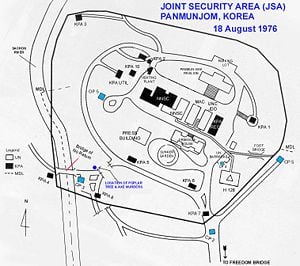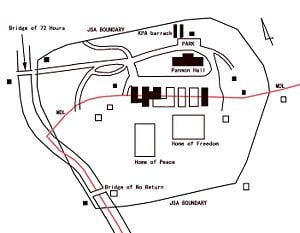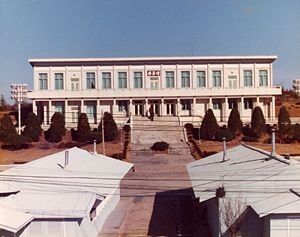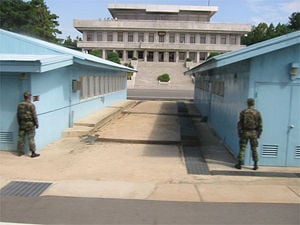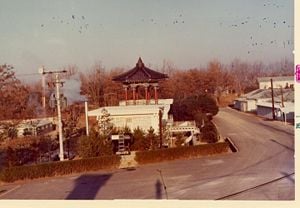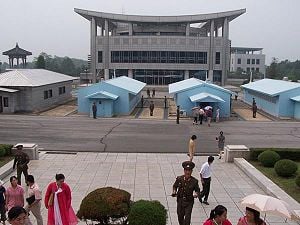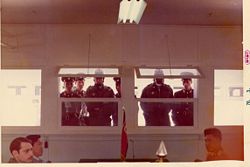Difference between revisions of "Joint Security Area" - New World Encyclopedia
Dan Davies (talk | contribs) (imported, credited, claimed) |
({{Contracted}}) |
||
| Line 1: | Line 1: | ||
| − | {{claimed}} | + | {{claimed}}{{Contracted}} |
{{otheruses4||the South Korean movie|Joint Security Area (film)}} | {{otheruses4||the South Korean movie|Joint Security Area (film)}} | ||
Revision as of 15:41, 7 September 2007
- For the South Korean movie, see Joint Security Area (film).
| Joint Security Area | ||||||||
|---|---|---|---|---|---|---|---|---|
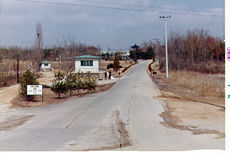 Welcome to the JSA | ||||||||
| Korean name | ||||||||
|
The Joint Security Area (JSA) or Panmunjom, often called the "Truce Village" in both the media[1][2] and various military accounts[3], is the only portion of the Korean Demilitarized Zone (DMZ) where South and North Korean forces stand face-to-face. The section is reserved between the two Koreas for diplomatic engagements, and until March 1991 was also the site of military negotiations between North Korea and the United Nations Command (UNC). The Joint Security Area is located at {{#invoke:Coordinates|coord}}{{#coordinates:37|57|21.60|N|126|40|36.50|E|type:landmark | |name= }} [2] lying within the village of Panmunjom.
The original village of Panmunjom encompassed a larger area than the current inter-military complex of the JSA, and consisted mostly of farms. The JSA itself is actually about 800 meters (1/2 mile) south of where the village proper actually was, though still within the village's old farming area. It is because of this proximity that there is often ambiguity between the terms JSA or Panmunjom. As a village, Panmunjom doesn't exist anymore as it was destroyed during the war, and all that now remains on the site of the village is the North Korea Peace Museum. Residing within the North Korean half of the DMZ where civilians are not allowed, the village has not been rebuilt or repopulated, but the name carries on and the name is now used to usually refer to the JSA. The village gained lasting fame as the site where the Korean Armistice Agreement was negotiated. General Nam Il and General Harrison signed the armistice agreement at 10:00 a.m. on 27 July 1953, in a hastily constructed pavilion at Panmunjom, General Mark W. Clark, Commander-in-Chief, UNC, and by Marshal Kim Il Sung, KPA Supreme Commander, and Peng Teh-huai, Commander, CPV, later countersigned the document in separate ceremonies at Munsan approximately 18 kilometers south of the DMZ and at Kaesong, approximately 10 kilometers to the north in separate ceremonies respectively.
The JSA has been the site of numerous major events since its establishment in 1953, the first of which was the repatriation of Prisoners of War (POW's) after the cessation of hostilities, across the Bridge of No Return. The JSA is also portrayed in the movie of the same name, Joint Security Area. However, there are no landmines within or around the area as illustrated in the movie.[4]
Originally established as a U.S. Army organization, the JSA quickly incorporated ROK soldiers (KATUSAs) to give South Korea representation in the area as well. Since the signing of the armistice, until relatively recently, the UNC unit (Joint Security Force), charged with providing security for the area, consisted almost largely of U.S. Army soldiers with a significant contingent of KATUSAs. Today, the unit is comprised of a U.S. Army Commander, LTC Michael Anastasia, with operational control of the unit and a ROK Army deputy commander with administrative authority over the largely ROK Army members of the unit. There also continues to be a U.S. Army staff of several officers and a a dozen or so NCOs.[5]
The Joint Security Area currently has around 100,000 tourists visit each year through several tourism companies[6][7] and the USO[8] (through the various U.S. military commands in Korea). Before being allowed to enter the DMZ, tourists are given a briefing during which they must sign a document which states, in part, "The visit to the Joint Security Area at Panmunjom will entail entry into a hostile area and possibility of injury or death as a direct result of enemy action."[9][10][11] Primarily tour companies from South Korea, Japan and the USO conduct tours. North Korean citizens are not allowed access on the tours, but citizens of other nationalities are.[12]
Establishment
Among the provisions of the Korean Armistice Agreement signed July 27, 1953, to bring a cease-fire in the Korean War, was establishment of the Military Armistice Commission (MAC), an agency to supervise implementation of the truce terms. Meetings of MAC representatives from the United Nations Command (UNC) and the Korean People's Army/Chinese People's Volunteers (KPA/CPV) were held at the Joint Security Area, an 800 meter-wide enclave, roughly circular in shape, bisected by the Military Demarcation Line (MDL) separating South and North Korea, and created as a neutral area, where there was free movement of both sides anywhere within the JSA boundaries.
Military Police of both sides provide security for the JSA with guard forces of no more than 35 security personnel on duty at any given time. The administrative facilities for both guard forces are located within the JSA..[13]
Layout
While the boundary has remained the same over the years, the buildings have changed. Some have gone away, like all of the KPA checkpoints on the southern half of the JSA, new ones have been built, and others have just been renovated or expanded. The only boundary change of the Joint Security Area was the enforcement of the dividing line within the JSA after the murders of two American officers in 1976. Prior to this, the entire area was a neutral area, where members of either side had free movement within the JSA.
Since the enforcement of the Military Demarcation Line (MDL) within the JSA, several UNC checkpoint buildings have also been rebuilt and/or renamed as well. Examples of this are what was called Observation Post (OP) #5 on the hill overlooking the Bridge of No Return, is now Checkpoint (CP) #3[14], while what used to be called CP#3 (and sometimes called "The Loneliest Outpost in the World" [15][16]) was the UNC checkpoint at the southern end of the Bridge of No Return. After the enforcement of the MDL however, the North Koreans no longer had a road leading into the JSA, and within 72 hours, built what has now become known as the "72 Hour Bridge" (or "Bridge of 72 Hours").
Major Landmarks
Notable landmarks within the JSA include the Bridge of No Return and the tree where the Axe Murder Incident of 1976 took place.
In the pictures above, the small blue building on the left is the MAC Conference Room, where talks take place between both sides, while the one on the right was the UNC Joint Duty Office building. These buildings are set squarely on the MDL, which bisects the center of a green-felt-covered conference table inside the MAC Conference Room. Since the Commission headquarters of each side is located outside the conference area — in Seoul for the UNC and in Kaesong for the KPA/CPV — both sides maintain a Joint Duty Officer (JDO) at the JSA to provide continuous liaison. The JDOs meet to pass communications from the senior member or secretary of their sides. The Neutral Nations Supervisory Commission (NNSC) also has buildings inside the JSA to conduct business, but after the fall of communism in Poland and Czechoslovakia (the KPA/CPV delegation), North Korea dismissed them from representing their side, leaving only Sweden and Switzerland (the UNC delegation) as representatives.
The above pictures also show an expansion over the years of the main North Korean building in the area, Panmungak. The North Koreans however haven't been the only ones expanding or constructing new buildings. On July 9, 1998, South Korea constructed a newer (and much larger) Freedom House within the JSA.
Composition and Duties
The United Nations Command Security Battalion—Joint Security Area was constituted on May 5, 1952, as Army Unit 8020, United Nations Command Military Armistice Commission Support Group ( Provisional ). Originally authorized five officers and ten enlisted soldiers, the unit quickly grew to over 1,400 officers and men charged with supporting almost 32,000 soldiers, civilians, and diplomats involved in negotiating and then enforcing the Armistice Agreement. By the end of February 1954 the scope of work declined considerably and the number of soldiers assigned to the unit declined as well.
For the next fifty years the unit underwent several organizational and name changes, although the original mission to secure the Joint Security Area remains the same today as it was in 1952. On June 11, 1979, the name was changed from US Army Support Group (Joint Security Area) to United Nations Command Support Group—Joint Security Area, and further changed to United Nations Command Security Force—Joint Security Area on December 23, 1985. On October 15, 1994, UNC Commander directed that the unit be known by its present designation, the United Nations Command Security Battalion—Joint Security Area .
Originally a purely U.S. Army organization, the unit almost immediately incorporated ROK soldiers (KATUSAs) into its ranks. In addition, ROK Army officers served as liaison officers. In the mid 1970s the JSA consisted of the JSF company with three platoons of one U.S. and one ROKA officer, and thirty enlisted men, supported by a battalion staff. The three platoons were lead by the U.S. officer with the ROK officer being the executive officer, and US Army platoon sergeants. The platoons consisted of three squads, with equal numbers of U.S. and KATUSA soldiers. Sometime after 1979, another (fourth) platoon was added to the JSF to allow time for training during platoon work rotations. In July 1987 the four platoons of the Joint Security Force (JSF) company were reorganized to mix KATUSA and US soldiers at all levels. At the platoon level, two platoons were led by US Army lieutenants and ROKA platoon sergeants, and two were led by ROKA lieutenants and US Army platoon sergeants. In November 1987 the unit received a ROK Army major as its first deputy commander.
On April 25, 1992, the JSF company became a KATUSA-pure formation. Captain Yin, Sung-Hwan became the first ROK commander, assisted by a US Army lieutenant as his executive officer. The number of US Army personnel assigned to the unit fell below 200 for the first time since 1952. At this time the security forces within the JSA became made up of solely KPA and ROKA soldiers, increasing tensions as South Korea refused to sign the Armistice Agreement and is technically still at war with North Korea. American forces assigned to the JSA assumed mainly administrative and support roles.
On October 31, 2004, a ROK Army battalion assumed responsibility for the Joint Security Area.[17] This modified light infantry battalion consists of a battalion headquarters, a headquarters company, two security companies, and a civil affairs company. The number of US personnel assigned decreased further, reflecting the UNC Commander's desire to minimize the USFK presence near the Korean Demilitarized Zone. The commander of the ROKA JSA Battalion serves as the UNCSB-JSA Deputy Commander. The UNCSB-JSA Commander's principal responsibility now lies in his operational control of selected ROKA formations during both Armistice and wartime periods.
History and Major Events
During one of the initial negotiations of the armistice, the UNC side went into the truce tents one night and sawed down the chair legs of the KPA/CPV delegation. The next day, when the KPA/CPV delegates arrived, they were forced to sit lower than their UNC counterparts and lost face, so they quickly left the meeting. At a later meeting, the UNC delegation brought a flag into the truce tent and set it up on the meeting table. Again, the KPA/CPV delegation left after losing face, but showed up at the next meeting with a flag that was larger than the UNC flag. At the following meeting, the UNC delegation brought in a slightly larger flag. This kept up until a special meeting was called just to discuss the size of the flags, as they had grown too large to fit within the tents. The size of the flags within the meeting building have stayed about the same since then, with only minor changes. The KPA flag is wider than the UNC flag, but the UNC flag is longer. The KPA flag has thicker fringe around the edges of the flag, but the UNC's trim is longer. The bulb at the top of the KPA flagpole is taller than the UNC bulb, but the UNC's is wider. The KPA flag has a three tiered base while the UNC flag only has two tiers, but each of the tiers on the UNC base is taller than any of the tiers on the KPA flag.
Being at the center of one of the world's most tense military and political fault lines, the Joint Security Area has been the scene of over 750 overt acts of violence. The UNC has documented with reports and photographs, most of these incidents, which have been reported in the course of MAC meetings. The events listed below are only the most egregious. Countless fistfights, shouting matches, exchanges of rude gestures, and other provocations have occurred since 1953.[18]
- Operation Little Switch, April 1953
- This operation was a test case for prisoner repatriation, one of the four main issues of contention during two years of negotiation. 605 sick, wounded, and/or injured UNC prisoners were exchanged for 6,030 sick or injured Communist prisoners.[19][20]
- Operation Big Switch, April-September 1953
- Based on the success of the repatriations undertaken earlier, a general exchange of prisoners began in late April. During Operation Big Switch, prisoners were brought to Panmunjom, on the banks of the Sachong River. Each prisoner was then asked if he wished to cross the river and return to his countrymen or remain with his captors. Once the choice was made there was no turning back—hence the name Bridge of No Return. During this time 13,444 UNC prisoners returned to UNC countries, and 89,493 KPA and CPV prisoners returned to their Communist countries. In March, 1953, a further 25,000 KPA soldiers held in ROKA camps had been released into South Korea on President Syngman Rhee's orders in an attempt to wreck the armistice negotiations.[21][22][23]
- Operation Movement of Custodial Forces—India, September 2, 1953
- The Armistice Agreement provided that a nonbelligerent nation would provide security forces to hold any prisoner of war who refused repatriation. India provided 6,413 soldiers for this purpose. After landing at the port of Inchon, the UNCMAC Support Group (Provisional) moved all personnel to the Demilitarized Zone by helicopter in a single day without incident.
- Operation Comeback, January 21, 1954
- Approximately 23,000 KPA and CPV soldiers held in UNC prisoner-of-war camps refused to return to Communist control. Twenty-one UNC soldiers (20 Americans, one Briton) also refused repatriation. Under the provisions of the Armistice, these soldiers were held for a further six months and interviewed by neutral observers to ensure they had not been coerced into refusing repatriation. Most KPA expatriates remained in South Korea, while the overwhelming majority of CPV expatriates traveled to Taiwan to join the Nationalists.
- Operation Rainbow, March 1954
- During this operation the UNCMACSG(P) oversaw the repatriation of displaced persons, expellees, and refugees from North Korea to South Korea across the Military Demarcation Line at Panmunjom.
- On August 29, 1967, at 1645 hours, KPA soldiers armed with small arms and light machine guns attacked the United States Army Support Group Advance Camp (now known as Camp Bonifas.) During this attack one US soldier and two ROKA soldiers were killed. An additional twelve US soldiers, nine ROKA soldiers, and three ROK civilians were wounded. The KPA soldiers were pursued to the MDL by US soldiers from the Advance Camp. Following this incident the southern boundary fence for the DMZ was relocated to a line north of the camp's perimeter.
- On April 14, 1968, at 2300 hours, KPA soldiers ambushed a UNC truck transporting food and supplies to Observation Post Oullette. Using small arms & automatic weapons fire and hand grenades, the KPA soldiers succeeded in stopping the truck and attempted to kill all six soldiers aboard. They withdrew across the MDL after killing four of the soldiers (two US and two ROKA) and wounding the remaining two soldiers.[24][25]
- Operation Breeches Buoy, December 23, 1968
- On December 23, 1968, Commander Lloyd M. Bucher and his 81 crewmen from USS Pueblo crossed the Bridge of No Return to freedom.[26] They had spent the previous eleven months in captivity. They endured torture, neglect, and malnutrition at the hands of the KPA after their unarmed electronic surveillance ship was attacked and seized by DPRK naval forces on January 22, 1968. They were the last group of UNC personnel to cross the Bridge of No Return.
- Operation Temple Bell, December 1969
- In December 1969 an unarmed OH-23 observation helicopter strayed over DPRK airspace and was forced to land in North Korea. The crew was held for a short time, then returned to UNC control.
- Operation Runaway I, February 14, 1970
- A Korean Airlines aircraft was hijacked by Communist sympathizers and forced to divert to Pyongyang. The 39 ROK citizens aboard the aircraft could not be immediately repatriated because of the state of war still existing between the two Koreas. They were finally returned through Panmunjom on Valentine's Day, 1970.
- On October 12, 1970, at 1100 hours, two KPA guards and one KPA officer approached a group of UNC guards. The KPA soldiers attempted to remove the MP brassard from one UNC guard; a shoving match ensued. The KPA guards disengaged, moved to the KPA Joint Duty Officer building and returned with approximately 30 KPA guards and workers. Armed with shovels, clubs, and rocks, the KPA workers initiated a melee. One UNC guard was isolated from the rest, dragged between the MAC and JDO buildings, and beaten on the head with a shovel. Shortly afterward 50 unarmed UNC guards from the UNC JDO building arrived and joined the fray and began isolating and disabling KPA guards on the UNC side of the MDL. Fighting ceased when two KPA guards emerged from a guard post armed with AK-47 rifles. Seven UNC guards suffered injuries, including one with a skull fracture.
- On March 3, 1974, at 1415 hours, a KPA officer and two KPA guards approached a UNC-sponsored tour at UNC Observation Post 5 (now UNCP #3). The UNC escort officer prevented the KPA group from harassing the tour group, at which point the KPA officer grabbed the UNC officer's shoulder. At the same time one of the KPA guards kicked the officer in the back and groin. Approximately 25-30 KPA personnel moved to the site and isolated the UNC officer, preventing him from returning to UNC Check Point 4 until the UNC Quick Reaction Force arrived on scene and dispersed the KPA soldiers. After the UNC QRF departed with the injured officer, KPA guards returned, broke into Check Point 4 and began to vandalize the interior. The QRF redeployed to Check Point 4 and forced the KPA away. The KPA responded by sending approximately 100 additional soldiers to KPA Guard Post #7 at the west end of the Bridge of No Return. The UNC JDO arrived on the scene and prevented an escalation by proposing an immediate Security Officers' Meeting. However, upon withdrawing from the area to convene the meeting, the JDO sedan was attacked by the KPA, who broke out the windows with rocks and clubs, injuring the JDO, after which all KPA forces withdrew to their side of the bridge.
- Major Henderson Incident - On June 30, 1975, at 1620 hours, a DPRK journalist with a history of provocative actions verbally accosted Major Henderson, the acting commander of the US Army Support Group. When Major Henderson failed to respond to the verbal insults and rude gestures, the journalist struck him in the face. Rising to protect himself, Major Henderson was attacked from behind by a KPA guard, who knocked him unconscious and then stomped on his throat, crushing his larynx. UNC and KPA guards from around the JSA immediately responded, and a melee ensued. The KPA guards attempted to inflict further injuries to Major Henderson as he was evacuated. KPA guards also assaulted a UNC-sponsored newswoman, who was hit in the face. The JSF commander arrived on the scene, confronted the fighters, and ended the incident by demanding an immediate Security Officers' Meeting. Major Henderson was evacuated from the area and eventually transported to the United States for treatment and rehabilitation.
- Axe Murder Incident - On August 18, 1976, at 1040 hours, North Korean guards attacked a United Nations Command work party which was pruning a large tree obscuring visibility between two UNC checkpoints. During the fight, two US soldiers (Capt. Bonifas and Lt. Barrett) were killed by the KPA using axes dropped by the fleeing work party.
- Operation Paul Bunyan, August 21, 1976
- In response to the brutal murder of two US Army officers by the KPA on 18 August, the UNC Commander, General John W. Vessey, Jr. ordered a massive show of force to accompany the felling of the poplar tree inside the JSA. The tree had been the focal point of the murders.
- On November 23, 1984, at approximately 1130 hours, during a Communist-led tour, Soviet citizen Vasily Matusak suddenly dashed across the Military Demarcation Line into South Korea. 30 Communist soldiers pursued him, firing their weapons as they did so. The JSF commanded by Captain Bert Misuzawa deployed from Camp Kittyhawk to safeguard Matusak and repel the North Koreans. The KPA soldiers were quickly outmaneuvered and isolated in the area of the Sunken Garden, now the site of the Unification Monument. In the 21-minute firefight that ensued, Private First Class Michael A. Burgoyne was wounded, and Corporal Jang, Myong-Ki was killed.[27] The JDO NCO negotiated a cease-fire that enabled the North Koreans to withdraw, but not before five Communists were wounded and three killed. It has been rumored that Lt. Pak Chul (Lt. Bulldog) was one of those killed in this firefight, though documentation has not been found yet. However, he has not been seen in the JSA since this incident.
- KPA Abandonment of the MAC Meetings, March 1991
- In March, 1991, the UNC commander appointed a South Korean General as chief representative. As North Korea claims that only signatories to the Armistice Agreement, of which South Korea is not a part, can be representatives, they refuse to attend any more MAC meetings.[28]
- Operation Popeye, February 1, 1994
- In January 1994 two KPA soldiers were swept into the East China Sea. They were rescued by elements of the ROK Navy. Neither soldier wished to defect, so they were returned to Communist control through Panmunjom.
- Operation Bobby Hall, December 29, 1994
- In December 1994 an unarmed OH-58 Kiowa helicopter from the US Army crossed the MDL during foul weather. KPA air defense forces shot the aircraft down[29]; co-pilot David M. Hilemon was killed. Pilot Bobby Hall was released 13 days later, after signing an apology for “accidentally straying” into North Korean airspace.
- A number of defections have taken place over the years, the most recent being the defection of North Korean People's Army Senior Captain Byun on February 3, 1998.
Gallery
See also
- List of Korea-related topics
- Korea
- Geography of North Korea
- Geography of South Korea
External links
- Satellite image from WikiMapia or Google Maps
- Mapping from Multimap or GlobalGuide
- Satellite image of the JSA from Google Maps
- Satellite Image of JSA from Google Earth
ReferencesISBN links support NWE through referral fees
- ↑ Korea Truce Village At Peace
- ↑ Despite tensions, tourists flock to Korean DMZ
- ↑ Democratic People’s Republic of Korea (DPRK)
- ↑ Gongdong gyeongbi guyeok JSA
- ↑ This information was obtained from LTC Anastasia from April 26-28, 2007, at the JSA Veterans Reunion in Las Vegas, NV.
- ↑ Panmunjom Tour Travel Information Center
- ↑ DMZ Tour Guide
- ↑ PANMUNJOM (DMZ) TOUR
- ↑ Panmunjom By Jennifer Lee '98
- ↑ Surreal, sobering visit to Korea's Demilitarized Zone
- ↑ VISITORS DECLARATION (UNC REG 551-5)
- ↑ [1]
- ↑ UNC Reg 551-1, Compliance With the Korean Armistice Agreement URL retrieved November 29 2006
- ↑ Cohen: Economic Failure Plagues North Korea
- ↑ AMERICATREK PART SIX, FINAL PART, VESTIGES OF THE COLD WAR
- ↑ Panmunjom
- ↑ Leadership of Joint Security Area at DMZ transferred to S. Koreans URL retrieved December 3, 2006
- ↑ Records of the UNC Military Armistice Commission (UNCMAC)
- ↑ Bernstein, Barton. “The Struggle over the Korean Armistice: Prisoners of Repatriation?” in Child of Conflict: The Korean-American Relationship 1943-1953,ed. Bruce Cumings (1983).
- ↑ U.S. Army Forces, Far East, 8086th Army Unit, Military History Detachment.Operation Little Switch, 4 vols., n.d.
- ↑ Syngman Rhee Biography: Rhee Attacks Peace Proceedings
- ↑ The Korean War: Years of Stalemate, pg 30
- ↑ THE KOREAN WAR 1950-1953, pg 245
- ↑ DMZ ambush survivors seen lucky to be alive URL retrieved December 3, 2006
- ↑ Survivor thought ambush was all-out attack URL retrieved December 3, 2006
- ↑ Pueblo crew of 82 freed by N. Korea URL retrieved December 3, 2006
- ↑ Soldiers gather to honor KATUSA killed at Korean JSA in 1984 URL retrieved December 3, 2006
- ↑ DPRK, UNC to Resume High-Level Military Talks
- ↑ Press Release - OH-58C Helicopter Down in North Korea URL retrieved December 3, 2006
Credits
New World Encyclopedia writers and editors rewrote and completed the Wikipedia article in accordance with New World Encyclopedia standards. This article abides by terms of the Creative Commons CC-by-sa 3.0 License (CC-by-sa), which may be used and disseminated with proper attribution. Credit is due under the terms of this license that can reference both the New World Encyclopedia contributors and the selfless volunteer contributors of the Wikimedia Foundation. To cite this article click here for a list of acceptable citing formats.The history of earlier contributions by wikipedians is accessible to researchers here:
The history of this article since it was imported to New World Encyclopedia:
Note: Some restrictions may apply to use of individual images which are separately licensed.
